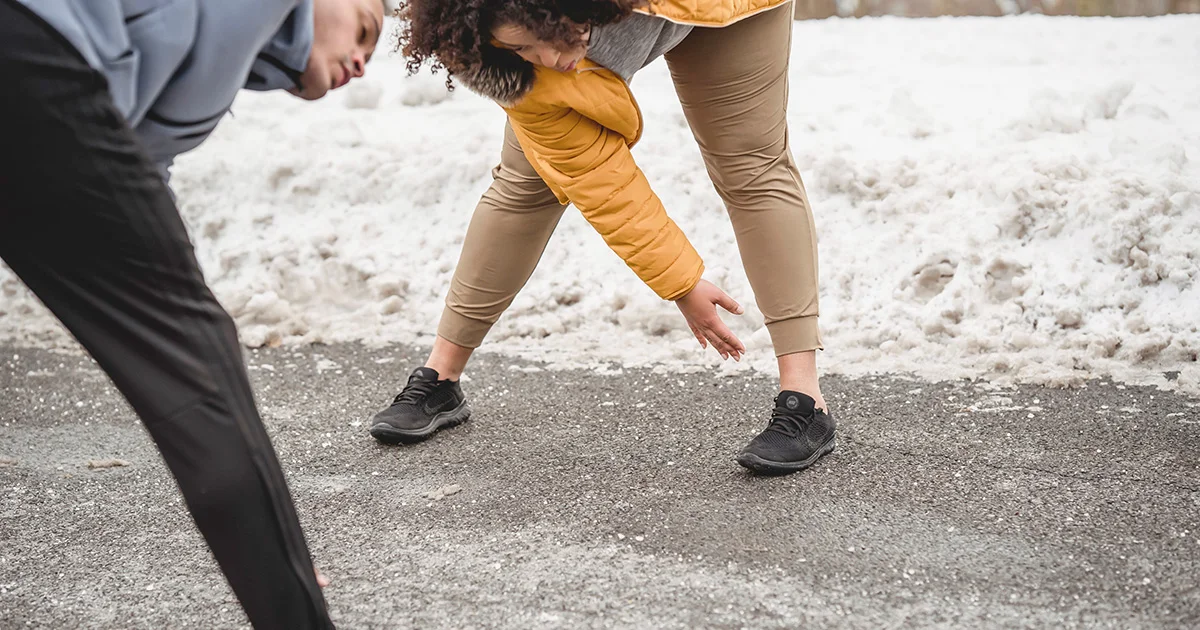Here's what we'll cover
Here's what we'll cover
For such a natural and straightforward process, there can be a lot to learn as a beginner runner. The way you place your feet, how you hold your arms, and what you eat and drink can all affect the quality of your runs.
You also might not even realize how much the way you breathe can influence your performance and make you a better runner. After all, breathing while running is just automatic—right?
Well, it turns out that learning how to breathe properly while running can have a host of benefits, including boosting your performance and helping you avoid injuries. You'll want to try some of these tips on your next run.
Why should you learn how to breathe while running?
Exercise is when two of the most essential organs in your body shine: your heart and your lungs (European Respiratory Society, 2016).
Your lungs bring oxygen into your body to provide energy and remove carbon dioxide waste, while your heart pumps the oxygen to your muscles that are hard at work (European Respiratory Society, 2016).
When you run and your leg muscles are working hard, your body uses more oxygen and produces more carbon dioxide. To cope with these added demands, your breathing rate increases from around 15 times per minute to up to 40–60 times per minute. Your heart rate also speeds up to carry additional oxygen to your muscles to keep them moving (European Respiratory Society, 2016).
Many new runners quickly find themselves easily out of breath on their first runs. This could mean that they’re attempting to run too fast or too far for their endurance level. It can also be due to not using proper breathing techniques while running.
How to breathe properly while running
You may need to try out several different breathing rhythms to choose the one that feels most comfortable to you. In general, you will want to avoid shallow breathing from your chest and instead focus on deep breathing from your belly. The best breathing technique for you will often develop by itself with time and practice.
1. Be sure to warm up
Warming up isn’t just for your leg muscles; it can also help prevent side stitches. Researchers don’t know exactly what causes them, but stitches happen when the diaphragm—the muscle that plays a significant role in your breathing—starts cramping.
Warming up your diaphragm muscle before a run can help prevent side stitches. Start by practicing diaphragmatic breathing (see below) and focus on maintaining it while you do the rest of your warm-up routine. As you increase your speed, your diaphragm will adjust to your harder breathing.
2. Practice diaphragmatic breathing
Diaphragmatic breathing, or deep belly breathing, increases the amount of oxygen you take in while running. To practice, breathe in through your nose for about two seconds. Make sure the air pushes your stomach outward while your chest remains relatively still. Purse your lips like you’re using a straw, then gently press on your stomach and exhale for about two seconds.
A study looked at diaphragmatic breathing in both people with chronic obstructive pulmonary disease (COPD) and healthy control subjects. The results showed that with practice, both groups developed greater lung volumes, better oxygenation, and lower breathing rates (Cancelliero-Gaiad, 2014).
3. Try rhythmic breathing
Breathing in a rhythmic pattern allows you to take in more oxygen and puts less stress on your body. With rhythmic breathing, you coordinate your foot strike with your inhalation and exhalation in an odd/even pattern. This means that you land alternately on your right and left foot as you exhale.
This type of breathing spreads the impact of running equally across both sides of your body. This can help prevent muscle imbalances and reduce injuries.
A common rhythm is the 3:2 pattern where you inhale for three foot strikes and then exhale for two. If you’re running at a faster pace, you can use a 2:1 pattern.
4. Try other breathing exercises
There are several other breathing patterns that you can try out. You may have to try several to find out which one feels best for you as you run.
4:4 Breathe in for four counts, hold for four counts, then breathe out for four counts and hold for four counts.
2:2 rhythm: Take two steps (one with the right foot and one with the left) while breathing in, and then two steps while breathing out.
3:3 rhythm: Inhale for three steps, and then exhale for three steps.
2:1 rhythm: Breathe in for two steps and out for one.
3:2 rhythm: Inhale for three steps and exhale for two. This one may work best on slow runs.
You might also want to experiment with yogic breathing (pranayama). There are several different techniques. They have been shown to have a positive effect on respiratory function in non-endurance trained individuals. While it may not significantly impact your running, participants in one study reported more positive perceptions of their workout (Seltmann, 2020).
5. Use the “talk test”
When you first start running, it's more important to focus on consistency and technique rather than how far or how fast you can run. Keep a comfortable pace. You should still be able to speak in complete sentences during your workout. If you’re breathing too hard to do that, slow down a bit. It's completely fine to walk for part or even all of your route at first as you build up endurance.
Is it okay to breathe through your mouth while running?
Other types of exercise, such as yoga or strength training, often focus on nasal breathing. This won’t provide enough oxygen for a runner, though. They need as much oxygen as possible.
Mouth breathing alone also isn’t the best solution either. It can cause a hyperventilating effect.
While there aren’t necessarily any studies evaluating this, some runners suggest that the best way for you to breathe while running is to inhale and exhale using both your nose and mouth at the same time. This will help to keep your breathing steady and your diaphragm engaged, allowing maximum oxygen intake. It will also enable you to expel carbon dioxide quickly.
This can feel weird at first. We’re usually conditioned to breathe in and out through just our noses, or in through the nose and out through the mouth. You may need to practice breathing through both your nose and mouth during the day.
How do you run without getting out of breath?
In addition to practicing breathing techniques for running, there are a few other ways you can help out your lungs for running:
Start slowly and build up your pace over time.
Avoid running when air quality is poor from pollen, smog, or nearby forest fires.
Avoid slumping your shoulders since it can restrict your breathing.
Schedule walk breaks during your run for recovery, especially if you’re new to running.
How do you breathe when running uphill?
Running up hills or at high elevations can put a lot of strain on your lungs and heart. This high-intensity exercise can cause your respiratory system muscles to become strained. This can cause you to experience more fatigue, lower oxygen levels, declines in running speed, and possibly impaired lung functioning (Bernardi, 2017).
Studies of runners have shown that steep slopes can result in less efficient breathing patterns. The effects were more pronounced at slopes greater than 20–30%. If your running plans include hills or mountain trails, this makes learning how to breathe correctly while running even more important (Bernardi, 2017).
Some additional tips for running up hills or at higher altitudes include reducing your intensity to lower your oxygen needs and using a 2:1 or 3:1 breathing pattern to help lower your heart rate and absorb more oxygen.
What should I do if I cannot breathe while running?
When your lungs are healthy, you keep a large breathing reserve even while exercising. That is, you aren’t usually breathing at your maximum capacity. You might feel a little “out of breath” after you run, but you shouldn’t feel “short of breath” (European Respiratory Society, 2016).
Your breathing should return to normal fairly quickly when you slow down. If you feel like you have trouble breathing while running, even during easy runs, or it takes a while for your breathing to return to normal, you should see a healthcare provider.
The following symptoms aren’t considered normal while exercising:
Feeling short of breath
Gasping
Wheezing
Feeling dizzy
Feeling faint
Feeling disoriented
If you experience any of these symptoms while running, you should stop immediately and seek medical attention.
DISCLAIMER
If you have any medical questions or concerns, please talk to your healthcare provider. The articles on Health Guide are underpinned by peer-reviewed research and information drawn from medical societies and governmental agencies. However, they are not a substitute for professional medical advice, diagnosis, or treatment.
Bernardi, E., Pratali, L., Mandolesi, G., Spiridonova, M., Roi, G. S., & Cogo, A. (2017). Thoraco-abdominal coordination and performance during uphill running at altitude. PloS One , 12 (3), e0174927. doi: 10.1371/journal.pone.0174927. Retrieved from https://www.ncbi.nlm.nih.gov/pmc/articles/PMC5376328/
Cancelliero-Gaiad, K. M., Ike, D., Pantoni, C. B. F., Borghi-Silva, A., & Costa, D. (2014). Respiratory pattern of diaphragmatic breathing and pilates breathing in COPD subjects. Brazilian Journal of Physical Therapy , 18 (04) doi: 10.1590/bjpt-rbf.2014.0042. Retrieved from https://www.scielo.br/j/rbfis/a/cWrmpJWLBbBWPz88x4dqvvx/?lang=en
European Respiratory Society. (2016). Your lungs and exercise. Breathe (Sheffield, England) , 12 (1), 97–100. doi: 10.1183/20734735.ELF121. Retrieved from https://www.ncbi.nlm.nih.gov/pmc/articles/PMC4818249/
Seltmann, C. L., Killen, L. G., Green, J. M., O'Neal, E. K., Swain, J. C., & Frisbie, C. M. (2020). Effects of 3 weeks yogic breathing practice on ventilation and running economy. International Journal Of Exercise Science , 13 (2), 62–74. Retrieved from https://www.ncbi.nlm.nih.gov/pmc/articles/PMC7039472/












